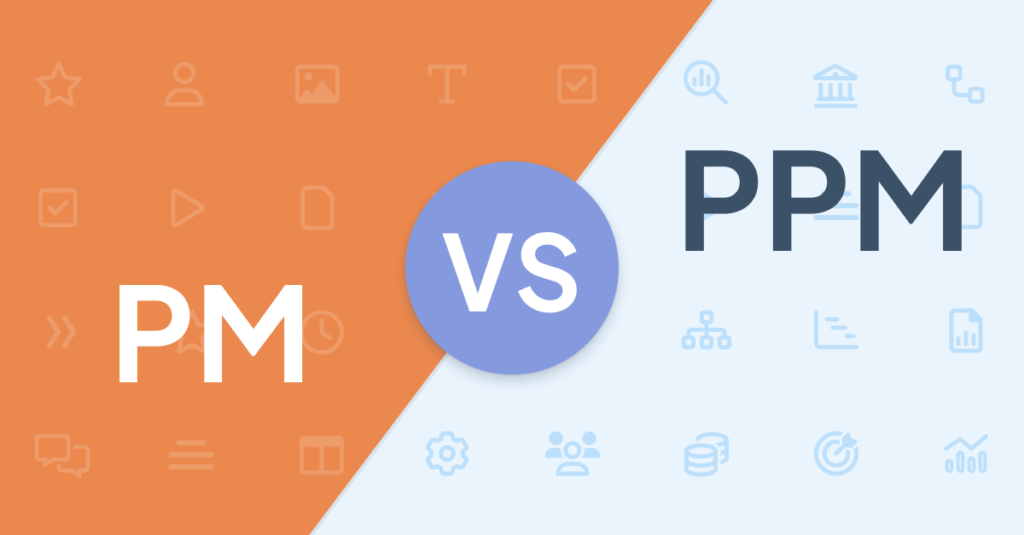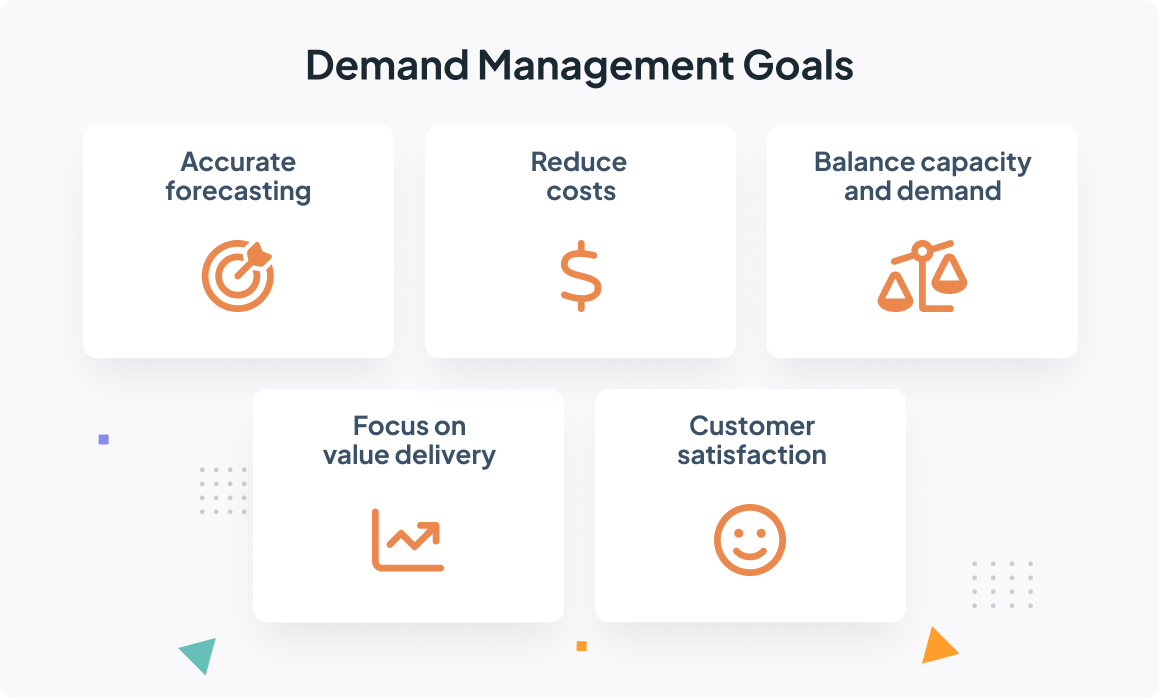What is Demand Management? The definitive guide for your IT department

Demand Management is increasingly becoming strategically important in the IT departments of all companies. We are in the era of digital transformation, where businesses must innovate and bring new products and services to market as soon as possible in order not to lose competitiveness in the market.
As a result, IT departments now have to handle a greater number of demand requests than ever before with limited resources. Increased volume of work, shorter lead times, limited resources and budgets: how to succeed in this context? By implementing processes that help balance this workload with available resources, such as Capacity Planning or Demand Management.
In this post, we will explain what Demand Management is, the components and activities that make-up the process, its benefits and some best practices to follow to help you make sure that the IT department is seen as one of the most relevant assets of your organization.
Understanding Demand Management
What is Demand Management? From Triskell we define it as a methodology with which organizations can plan, prioritize, manage and monitor requests for projects, products and services.
Like any methodology, it is made up of a series of components, processes and best practices that, when properly implemented, will bring countless benefits to the organizations that put them into practice.
This is one of the many definitions that can be found for this term. Different frameworks such as ITIL, PMBOK or PRINCE2 have their own interpretation of this concept, so it is difficult to find a definition on which all IT professionals agree.
Here we highlight some definitions of some of the most relevant Project Portfolio management frameworks:
What is Demand Management in PMBOK?
On the other hand, for PMBOK, Demand Management is an internal process of organizations by which they gather ideas, projects and needs as a previous step to the implementation of a program or portfolio. This ‘brainstorming’ must be aligned with the strategic objectives defined by company executives in order to prioritize and select those initiatives that will generate value for the business.
Scope of Demand Management
Once the different points of view on Demand Management have been presented, what is not up for discussion is the scope and objectives of Demand Management.
Regarding Demand Management’s scope, it focuses on the following points:
- Identify and analyze trends within the business activity that then generate demand requests for new products and/or services.
- Evaluate the different demand requests made by customers and users to identify possible behavioral patterns.
- Plan and prioritize the execution of demand requests based on strategic objectives and capacity planning. In other words, align demand management with the organization’s mission while ensuring that the necessary resources and technology are in place to satisfy the demand at the same time.
Demand Management Goals
As you can see, forecasting and planning are the two most repeated words when talking about Demand Management. But to focus only on these words would be to stay on the surface of the implications that this process really has when it comes to managing an IT Portfolio.
To talk about this process, it is necessary to emphasize the importance of customers and users. It is they who are at the center of this whole process. And if we do not obtain their satisfaction at the end of the process, all our efforts in analyzing, planning and managing demand will have been in vain.
These are, broadly speaking, the objectives of the Demand Management process:
- Predict incoming demand more accurately. Being able to identify patterns and trends that generate demand requests will improve decision-making processes when planning and managing demand, while improving other aspects such as Capacity Planning, Financial Management or Supply Chain Management.
- Focus on value delivery. Demand Management works in alignment with strategic objectives. This means that the demands that are prioritized and managed will generate value for the business.
- Balance demand with the organization’s capacity. It is a process that will help you improve the performance of your product and project portfolios and minimize problems of resource over- or under-allocation.
- Reduce costs. By more accurately predicting the volume of demand and the capacity needed to meet it, costs will be saved on issues such as hiring new personnel, acquiring new technologies or new inventory.
- Improve customer and user satisfaction. By studying user behavior patterns, you will better understand their needs, which will ultimately lead to a higher satisfaction rate with your products and services.
Components of Demand Management
Now that you know the objectives of Demand Management, let’s focus on the components and activities of this process. Demand Management is a key component of Project Portfolio Management, as it serves as a link between strategic planning and execution.
While Project Portfolio Management focuses on selecting and prioritizing the company’s projects based on their contribution to strategic objectives and their ability to generate value, Demand Management helps determine the volume of demand that the organization can handle. How? With a series of components that, being interconnected, give a clear vision of the projects and initiatives to be prioritized without compromising the organization’s capacity and Risk Management.
These are the components of the Demand Management process:
1. Demand modeling
It consists of representing in a simple way the demand request trends in the organization in order to understand and anticipate the behavior of customers and users.
2. Forecasting
It is based on the use of Data Analytics and Business Intelligence to predict the demand for products or services.
In this component of the process, it is especially important to have historical data from which to analyze all the demand managed by the organization in the past. This data must be used not only to estimate the volume of future incoming demand, but also other data of interest such as the budget or the resources that will be needed.
Having tools with which to simulate scenarios is essential for this component of the process to work properly.
3. Demand Planning
This process aims to anticipate or predict the volume of incoming demand in order to meet the needs of customers and users. It aims to find the right balance between the number of requests and the available inventory or resources and to avoid shortages or surpluses.
It is a process that must be flexible and adaptable to the strategic objectives and specific needs of each organization.
4. Supply planning
Finally, the purpose of this component is to determine the exact quantity of materials and products to be produced to meet customer demand. And all this while, in parallel, minimizing risks and maximizing profits for the organization.
Benefits of Demand Management
Once Demand Management is successfully integrated with the rest of the Project Portfolio Management processes you have in place, you will see that there are only advantages. It is a process that, if well implemented, will provide your organization with more revenue, greater responsiveness to change without undue obstacles or bottlenecks, and greater control over the organization’s ability to cope with demand.
There are five benefits of Demand Management for IT teams and companies in general:
- Cost reduction: thanks to demand management, companies can analyze and predict changes and trends in market demand, thus reducing costs associated, for example, with overproduction or stock-outs.
- Increased operational efficiency: by being able to anticipate and predict changes, IT departments will be able to optimize their production operations and reduce lead times, as well as optimize their product and service portfolios based on user needs.
- Organizational agility: by establishing processes to plan incoming demand and capacity, you will be more responsive and able to pivot when prioritizing demand, especially in turbulent times like the present.
- Increased competitive advantage: By planning demand and integrating it with the rest of the management and governance processes, you will detect more quickly those components and processes that only entail costs. You will focus all operations on delivering value.
- Improved customer satisfaction: with demand management, companies can anticipate and respond quickly to customer needs and preferences, which will improve the quality of their IT products and services and increase customer satisfaction.
Demand Management challenges
Customer satisfaction and Demand Management are closely interconnected. Users want more and better products in the shortest possible time. This forces organizations to implement processes of Continuous Improvement of their Demand Management Processes in order to address more efficiently all the challenges associated with this process.
These are the most common Demand Management challenges:
1. Accurate demand forecasting
In such turbulent times as we live in, with so many changes in user preferences, and with so many external factors influencing the strategic planning of organizations (political, economic, logistical factors, etc.), it is increasingly difficult to predict demand.
This makes both demand planning and resource management more difficult. Hence the importance of analyzing and studying changes in demand and trends so that organizations can react and adapt to changes.
2. Balancing supply and demand
Related to the previous point, the volatility of demand makes balancing supply and demand increasingly complex. It is important to have a management plan in place so that your supply chain is better prepared to deal with any obstacles that may arise, make any necessary changes and minimize risks.
3. Executive and Senior Management commitment
In order for the Demand Management process to be successful, it is necessary to have the strong support of the organization’s executives. They must be committed to the adoption of the process and to the creation of the necessary processes for its correct implementation.
Without their support, Demand Management would be disconnected from strategic planning, which in turn would lead to other problems in other areas such as Resource Management, Financial Management, Risk Management, etc.
4. The importance of breaking down silos
In addition to implementing the Demand Management process, it is necessary to promote an environment of collaboration between the various teams involved in the process.
This will avoid alignment misalignments between strategic planning and demand prioritization, or between demand planning and capacity planning, to mention the 2 most common mistakes.
Having a PPM software with features for Strategic Planning and Demand Management will help the process run smoothly.
5. Changing environments
Implementing the Demand Management process in complex and constantly changing business environments can be very demanding. Of particular relevance here are all activities related to demand analysis and demand sensing.
In this type of competitive environment, companies that can continuously optimize the accuracy of their demand forecasts (and pivot when that forecast has been incorrect) will have the greatest competitive advantage.
Demand Management Best Practices
To ensure that Demand Management is carried out effectively, it is essential to follow best practices that optimize resources, improve communication between teams and ensure alignment with business needs.
Here are some examples of best practices in Demand Management:
- Align demand prioritization with strategic objectives to optimize Resource Management or Financial Management and improve service levels.
- Constantly monitors market trends and consumer preferences to anticipate changes in demand and adjust supply accordingly.
- Uses scenario analysis tools to forecast demand and adjust capacity planning accordingly.
- Establish collaboration and communication processes between the different players and stakeholders of the Demand Management process in order to continuously optimize the process.
- Define realistic timelines when balancing supply and demand, especially in fast-changing environments, where planning demand 3 to 6 months ahead rather than a year ahead is often more accurate.
- Identify contingency plans to be implemented in case of errors in demand forecasting to minimize risks.
- Implement processes for the Continuous Improvement of Demand Management to reduce barriers and bottlenecks, while improving accuracy, throughput and efficiency.
Conclusion: Centralize your Demand Management processes on Triskell’s PPM solutions
As you can see, Demand Management is a critical aspect for IT departments that want to achieve operational excellence and customer satisfaction. Throughout this guide, we have explored in detail what Demand Management is, its scope, objectives, components, activities, benefits and associated challenges.
However, to get the most out of this process and ensure its success, it is crucial to have the right tools in place. In this sense, Triskell’s PPM solutions offer a comprehensive and powerful platform to centralize and optimize your Demand Management processes. With advanced features such as real-time visibility, efficient resource allocation and detailed reporting, Triskell gives you the control and agility you need to effectively manage project, resource and service demands.
Subscribe to our Newsletter
Get stories like this in your inbox
Request a demo of Triskell Software
Want to learn more? Request a free demo of Triskell Software and you will discover the PPM software that best suits your business needs.

FAQs about Demand Management
What is the difference between Demand Management and Capacity Planning?
While they are closely linked, Demand Management focuses on prioritizing and managing incoming requests, while Capacity Planning deals with assessing and optimizing the resources available to fulfill those demands.
Think of Demand Management as understanding what needs to be done, and Capacity Planning as figuring out how to do it effectively with the resources at hand. They work together to ensure a good fit between what’s requested and what can be realistically delivered.
How can Demand Management improve IT project delivery?
In the context of IT portfolio management, Demand Management can be particularly beneficial by:
- Centralizing request intake and review: This streamlines the process and ensures all requests are evaluated consistently based on predefined criteria.
- Prioritizing projects based on business value: IT teams can focus on projects that deliver the most significant strategic value to the organization.
- Improved resource allocation: By understanding IT resource capacity, project demands can be matched with available personnel with the appropriate skillsets, minimizing delays and bottlenecks.
What are some tools and techniques used in Demand Management?
Several tools and techniques can support effective Demand Management:
- Centralized demand management software: This provides a platform for capturing, prioritizing, and evaluating all incoming requests.
- Demand planning: Techniques are used to forecast the volume of incoming requests to ensure resource allocation aligns with future needs.
- Customizable request forms: Standardizing request intake with well-defined forms helps gather essential information for efficient evaluation and prioritization.
What are the benefits of Demand Management?
Demand Management offers several advantages, including:
- Focus on value delivery: By prioritizing requests aligned with strategic goals, you ensure resources are directed towards initiatives that generate the most business value.
- Balanced resource allocation: It helps avoid resource overload or underutilization by aligning project demands with available capacity. This leads to smoother project execution and improved team efficiency.
- Cost reduction: Accurate demand forecasting allows for better resource allocation, potentially reducing costs associated with hiring additional staff, acquiring new technologies, or managing excess inventory.
Related Content

6 time-consuming activities PMOs will leave behind with a PPM tool
Boost Productivity NOW! Top time-Consuming activities PMOs MUST ditch TODAY! Say goodbye to waste! Learn More.

Project Management vs Project Portfolio Management: understanding the differences
Explore the intricacies of Project Management (PM) and Project Portfolio Management (PPM) in this comprehensive guide.

The ultimate guide to create a Strategic PMO for impactful PPM
In this post, we will show you the key roles and responsibilities of a strategic PMO, as well as the essential components and best practices for its success.

